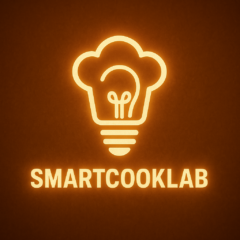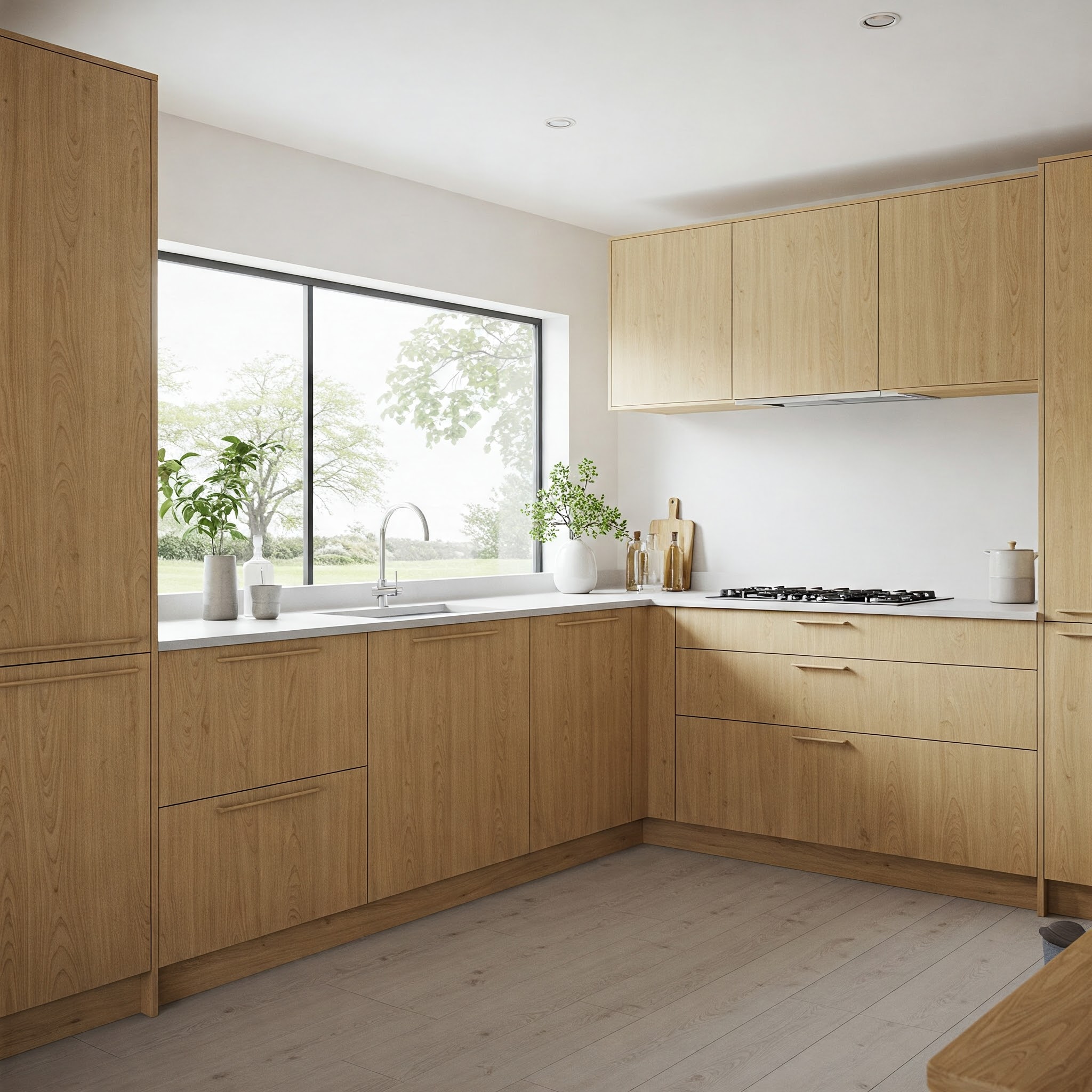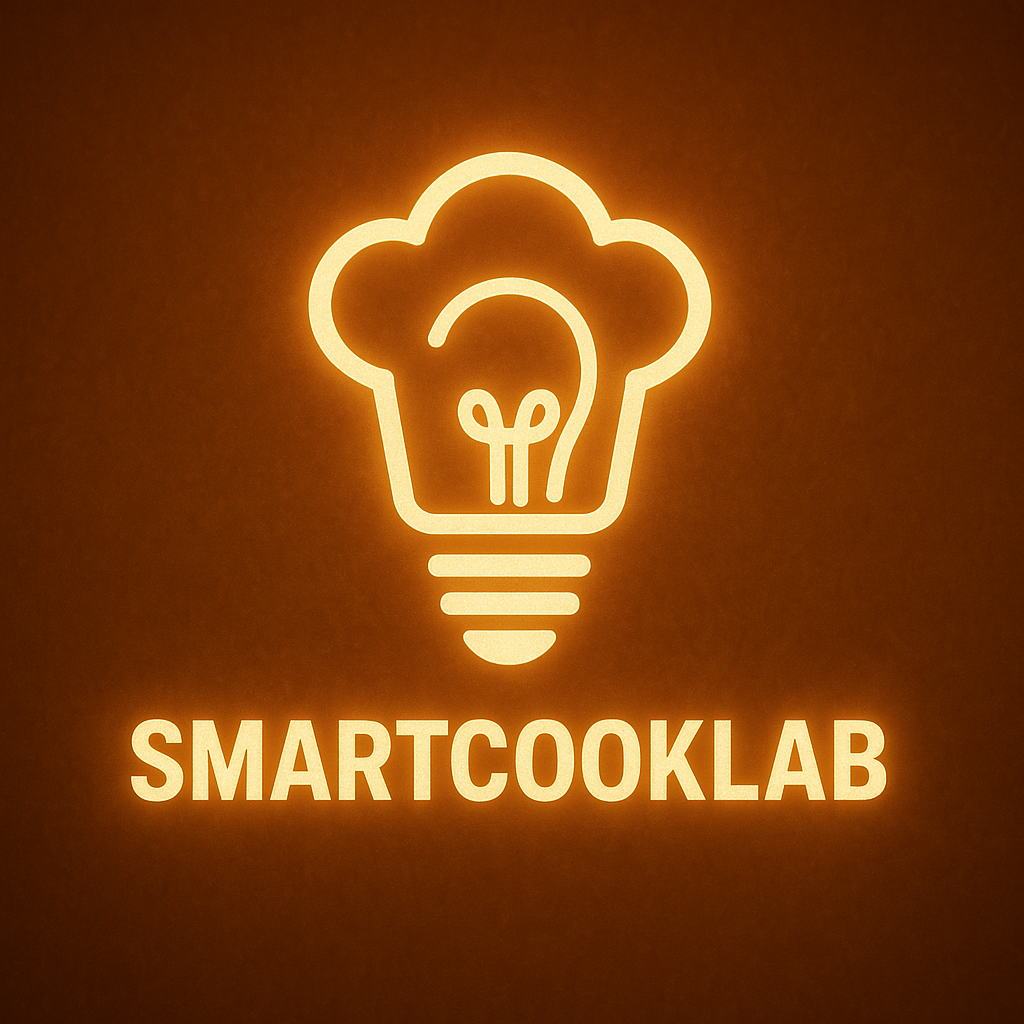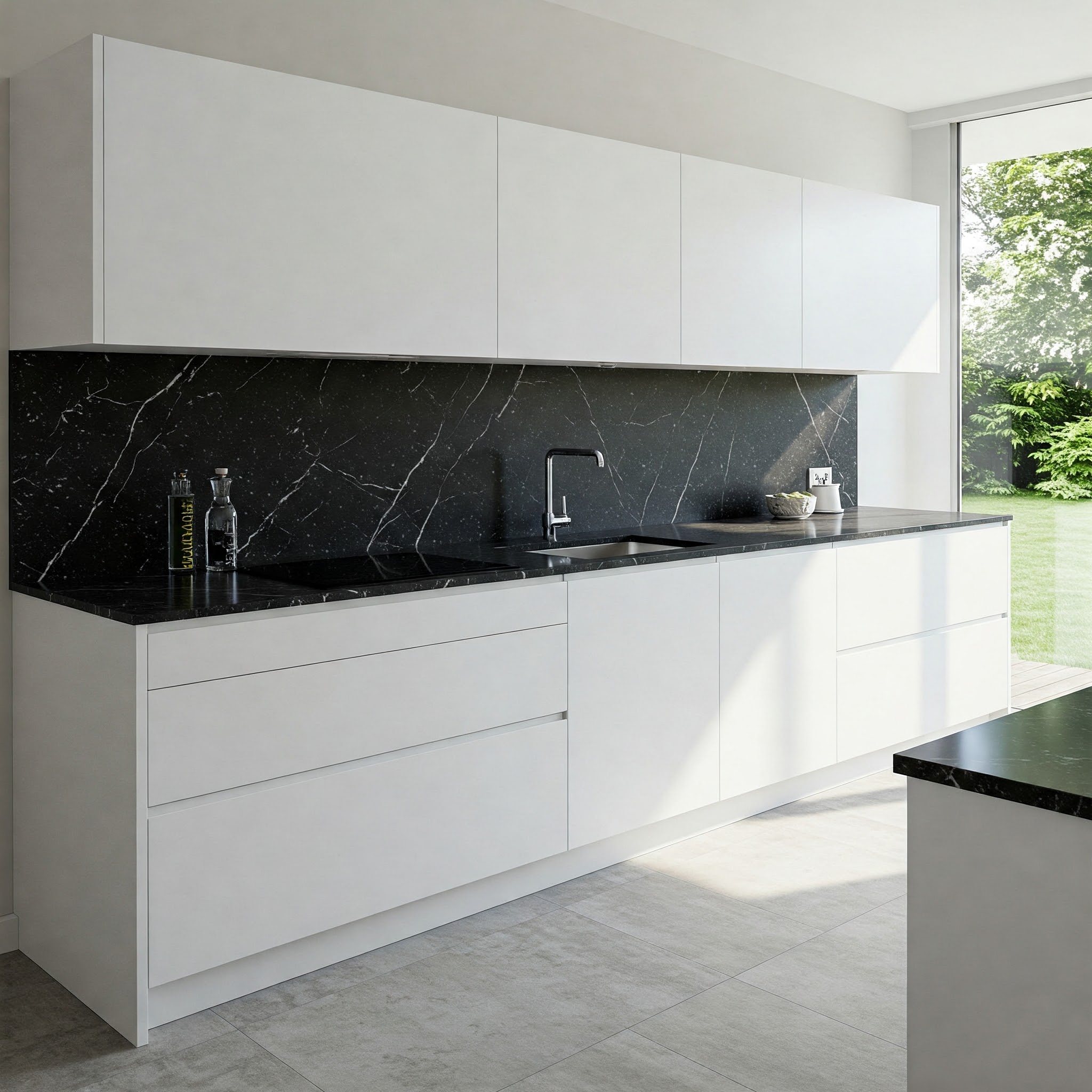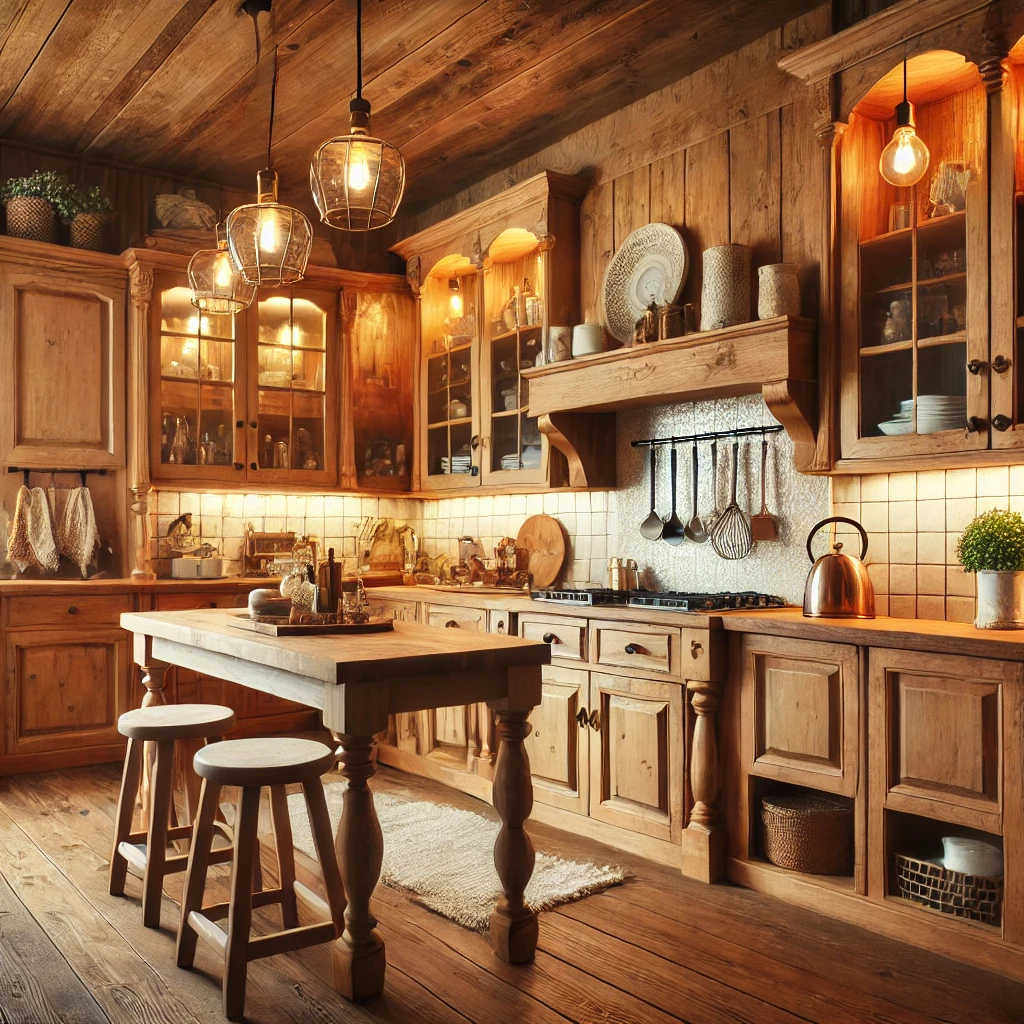Are you dreaming of a kitchen that combines sophisticated aesthetics with superior functionality? European kitchen cabinets might be exactly what you’re looking for. As an interior design specialist with over a decade of experience in kitchen renovations, I’ve witnessed firsthand how European kitchen cabinets can completely transform a space from ordinary to extraordinary.
✨Was this helpful? Spread the word! 🚀
European kitchen cabinets have gained tremendous popularity in American homes, and for good reason. Unlike traditional American cabinetry, which often emphasizes ornate details and classic styling, European designs embrace minimalism, clean lines, and innovative storage solutions that maximize every inch of space.
In this comprehensive guide, I’ll walk you through everything you need to know about European kitchen cabinets—from their distinctive characteristics and benefits to top brands, materials, and installation considerations. Whether you’re planning a complete kitchen renovation or simply looking to update your current space, this article will provide you with the knowledge to make informed decisions that align with your aesthetic preferences and practical needs.
What Are European Kitchen Cabinets?
European kitchen cabinets represent a distinctive style of cabinetry that originated in Europe, particularly in countries like Italy, Germany, and Sweden. These cabinets have evolved from the principles of European modernism, which emphasizes clean lines, functionality, and efficient use of space.
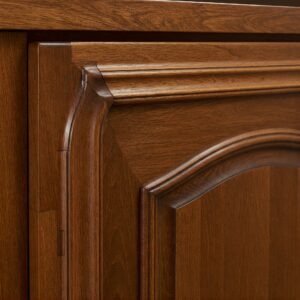
The European approach to kitchen design differs significantly from the traditional American style. While American cabinets often feature raised panels, visible hinges, and decorative moldings, European kitchen cabinets are characterized by:
- Frameless construction (full-access cabinetry)
- Sleek, handle-free designs or minimal hardware
- High-gloss or matte finishes
- Innovative storage solutions
- Integration with appliances
- Emphasis on horizontal lines
According to a study published in the Journal of Interior Design, European kitchen design philosophies prioritize ergonomics and workflow efficiency, creating spaces that are not only beautiful but highly functional for daily use.
Historical Evolution of European Kitchen Cabinets
The concept of European kitchen cabinets as we know them today began taking shape in the early 20th century, particularly after World War II when Europe faced housing shortages and needed efficient, space-saving solutions. The famous Frankfurt Kitchen, designed by architect Margarete Schütte-Lihotzky in 1926, is considered one of the first examples of modern fitted kitchen design with efficient cabinetry.
By the 1950s and 1960s, countries like Germany and Italy were leading innovations in kitchen design, emphasizing modular components and streamlined aesthetics. This approach gained international recognition and began influencing American kitchens by the 1980s and 1990s.
Today, European kitchen cabinets represent a design philosophy that has been refined over decades, combining technological advancements with aesthetic sensibilities that continue to evolve while maintaining core principles of functionality and clean design.
Comparing European vs. American Kitchen Cabinets
| Feature | European Kitchen Cabinets | American Kitchen Cabinets |
|---|---|---|
| Construction | Frameless (full access) | Framed with face frame |
| Hinges | Concealed | Often visible |
| Hardware | Minimal or absent | Decorative pulls and knobs |
| Aesthetics | Sleek, modern, minimalist | Traditional, often ornate |
| Cabinet Height | Floor-to-ceiling maximization | Standard heights with soffits |
| Materials | High-quality engineered wood | Solid wood prevalence |
| Color Palette | Contemporary, bold options | Natural wood tones and whites |
| Storage | Innovative organizers built-in | Basic shelving predominant |
| Cost | Generally higher initial investment | Varies widely by quality |
💬 Just one click – help others make better buying decisions too!😊
Key Features of European Kitchen Cabinets
Frameless Construction
Perhaps the most defining characteristic of European kitchen cabinets is their frameless construction. Unlike American cabinets that typically have a face frame attached to the front, European cabinets eliminate this frame, creating what’s known as “full-access” cabinetry.
This design approach offers several advantages:
- Approximately 10-15% more storage space
- Easier access to cabinet contents
- Cleaner, more contemporary aesthetic
- No center stile obstruction in double-door cabinets
The frameless design relies on the structural integrity of the cabinet box itself, which is why European cabinets are typically constructed from high-quality engineered woods like medium-density fiberboard (MDF) or particleboard with melamine or laminate finishes.
Advanced Hardware Systems
European kitchen cabinets feature sophisticated hardware systems that contribute significantly to their functionality and aesthetic appeal:
✅ Soft-close hinges and drawer slides that prevent slamming
✅ Push-to-open mechanisms that eliminate the need for handles
✅ Integrated LED lighting systems
✅ Adjustable shelving with hidden brackets
✅ Pull-out and swing-out storage systems
These hardware innovations not only enhance the user experience but also extend the lifespan of the cabinetry by reducing wear and tear. According to a report by Research and Markets, the global market for specialized kitchen cabinet hardware continues to grow at approximately 6.2% annually, with European manufacturers leading innovation.
Sleek Door Styles
Unlike traditional American cabinets that often feature raised or recessed panels, European kitchen cabinets typically showcase:
- Slab doors with no panels or detailing
- High-gloss lacquered finishes
- Matte textured surfaces
- Handleless designs with integrated grip profiles
- Alternative materials like glass and metal accents
These door styles create a clean, uninterrupted visual flow that makes even smaller kitchens appear more spacious and uncluttered. The simplicity of the door design also allows other elements in the kitchen—like countertops, backsplashes, or statement lighting—to take center stage when desired.
Space Optimization
European kitchen cabinets excel at maximizing storage in creative ways:
✅ Tall cabinets that extend to the ceiling
✅ Deeper drawers for pots and pans
✅ Corner solutions that eliminate wasted space
✅ Vertical dividers for baking sheets and cutting boards
✅ Specialized inserts for utensils, spices, and small appliances
These space-saving innovations reflect the European sensibility toward efficient living, particularly in countries where average home sizes are smaller than in the United States. A study by the National Kitchen & Bath Association found that incorporating European storage solutions can increase usable kitchen storage by up to 30% compared to traditional cabinet configurations.
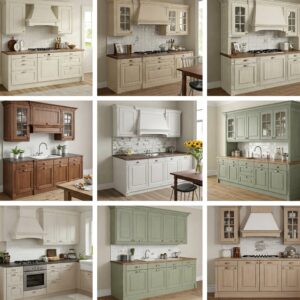
Popular Materials for European Kitchen Cabinets
High-Quality Engineered Woods
While solid wood dominates traditional American cabinetry, European kitchen cabinets frequently utilize engineered wood products that offer superior stability and consistency:
- Medium-Density Fiberboard (MDF): Provides an exceptionally smooth surface ideal for painted and lacquered finishes
- Particleboard with Melamine: Offers durability and moisture resistance at a more accessible price point
- High-Pressure Laminates (HPL): Delivers extreme durability and unlimited design options
These materials have evolved significantly over the years and now offer performance characteristics that often surpass solid wood in terms of dimensional stability and resistance to warping.
Innovative Finishes
European cabinet manufacturers are at the forefront of finish technology:
✅ Ultra high-gloss lacquers with mirror-like reflectivity
✅ Super matte finishes with fingerprint resistance
✅ Textured wood grain surfaces that mimic natural materials
✅ Metallic and pearlescent effects
✅ Nano-technology coatings that resist scratches and stains
One particularly notable innovation is the development of acrylic-based finishes that provide exceptional depth and clarity of color while offering superior durability compared to traditional lacquers.
Sustainable Options
European manufacturers have been leaders in sustainable cabinet materials:
- Formaldehyde-free board materials
- Recycled content components
- Water-based, low-VOC finishes
- FSC-certified wood products
- Bamboo and other rapidly renewable materials
According to the European Panel Federation, approximately 70% of wood used in European cabinet manufacturing comes from sustainably managed forests, reflecting the industry’s commitment to environmental responsibility.
Design Styles Within European Kitchen Cabinets
German Precision
German kitchen cabinets are renowned for their engineering excellence and precision manufacturing. Brands like Leicht and SieMatic exemplify the German approach with:
- Mathematically precise measurements and alignments
- Exceptional durability and longevity
- Sophisticated internal hardware systems
- Clean, architectural lines
- Neutral color palettes with emphasis on materials
German cabinets typically command premium prices but offer extraordinary quality that can last for decades with proper care.
Italian Flair
Italian European kitchen cabinets balance functionality with fashion-forward design. Manufacturers like Scavolini and Pedini are known for:
- Bold color choices and material combinations
- Cutting-edge design that often sets global trends
- Integration of artistic elements
- Curved and sculptural components
- Innovative use of glass and metals
The Italian approach often appeals to homeowners looking to make a dramatic design statement while maintaining the practical benefits of European cabinetry construction.
Scandinavian Simplicity
Scandinavian-inspired European kitchen cabinets emphasize warmth and natural elements within a modern framework. This style features:
- Light wood tones or white finishes
- Minimalist hardware or handle-free designs
- Integration with nature through materials and colors
- Thoughtful organization systems
- Emphasis on light and airiness
Brands like IKEA (at accessible price points) and Bulthaup (at the luxury end) have popularized elements of Scandinavian kitchen design globally.
Benefits of Choosing European Kitchen Cabinets
Superior Functionality
European kitchen cabinets are engineered with daily use and efficiency in mind:
✅ Ergonomic design principles that reduce strain
✅ Intuitive organization systems
✅ Accessible storage that eliminates searching and reaching
✅ Integration with appliances for a cohesive workflow
✅ Adaptability to changing needs over time
A properly designed European cabinet system can save homeowners significant time in meal preparation and cleanup while reducing physical stress during kitchen tasks.
Longevity and Durability
While the initial investment in European kitchen cabinets may be higher than some alternatives, their durability offers excellent long-term value:
- High-quality materials resist wear and damage
- Precision engineering ensures consistent performance
- Replaceable components allow for updates without full replacement
- Timeless designs that avoid quick obsolescence
- Sustainable practices that benefit the environment
Many European cabinet manufacturers offer warranties of 15-25 years, significantly longer than the industry standard, reflecting their confidence in product longevity.
Space Efficiency
For American homeowners dealing with space constraints—whether in urban apartments or smaller suburban homes—European kitchen cabinets offer remarkable space optimization:
- Vertical storage that utilizes ceiling height
- Interior fittings that maximize every cubic inch
- Specialized solutions for awkward corners and narrow spaces
- Multi-functional elements that serve multiple purposes
- Proportional sizing that creates visual harmony
These space-efficient designs can make even modest kitchens feel more generous and organized.
Clean Aesthetic
The minimalist approach of European kitchen cabinets creates visual benefits beyond style:
- Reduced visual clutter promotes a sense of calm
- Seamless integration creates flow between kitchen and living spaces
- Reflective surfaces can amplify natural light
- Absence of ornate details makes cleaning easier
- Neutral palettes provide versatile backgrounds for personalization
According to interior design psychology research published in the Environmental Psychology journal, these streamlined environments can positively impact mood and cognitive function in living spaces.
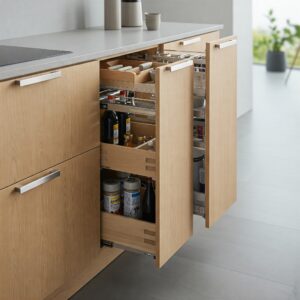
Top European Kitchen Cabinet Brands
Several manufacturers have established themselves as leaders in the European kitchen cabinet market, each with distinctive strengths:
High-End Luxury
For homeowners seeking the ultimate in European kitchen cabinets, these prestigious brands deliver exceptional quality and design:
- Bulthaup – Known for architectural precision and minimalist perfection, Bulthaup represents the pinnacle of German engineering with prices that can exceed $100,000 for a complete kitchen.
- Poggenpohl – As the oldest kitchen brand in the world (established 1892), Poggenpohl combines heritage with innovation, offering exquisite materials and craftsmanship.
- Valcucine – This Italian manufacturer emphasizes sustainability alongside stunning aesthetics, with glass and innovative materials featuring prominently in their designs.
Mid-Range Options
These brands offer excellent quality at somewhat more accessible price points:
- LEICHT – Combining German engineering with contemporary design, LEICHT offers customizable solutions with exceptional attention to detail.
- Scavolini – This popular Italian brand balances style and function with diverse finish options and intelligent storage systems.
- Nobilia – Germany’s largest kitchen manufacturer delivers reliable quality with modern European styling at relatively competitive prices.
Budget-Conscious Choices
European kitchen cabinet design principles are available at more accessible price points through:
- IKEA – While varying in quality, IKEA’s European-style frameless cabinets incorporate many design principles at remarkably affordable prices.
- Bauformat – This German manufacturer offers entry-level European designs without sacrificing the core principles of the style.
- Howdens – Popular in the UK but available internationally, Howdens provides European styling with practical features at moderate price points.
How to Choose the Right European Kitchen Cabinets
Assessing Quality Markers
When evaluating European kitchen cabinets, look for these indicators of quality construction:
✅ Cabinet box thickness of at least 18mm (3/4 inch)
✅ Drawer boxes with dovetail or metal construction
✅ Drawer slides rated for at least 75 pounds
✅ Hinges from recognized brands like Blum, Grass, or Hettich
✅ Water-resistant interior surfaces
✅ Perfectly aligned doors and drawers
❌ Visible glue residue at joints
❌ Inconsistent gap spacing between components
❌ Low-quality backing materials
Remember that higher quality components typically translate to longer cabinet lifespan, making them a better investment despite higher initial costs.
Material Selection Based on Lifestyle
Your household’s specific needs should influence material choices:
- Families with young children might prefer matte finishes that hide fingerprints
- Serious cooks benefit from heat and moisture-resistant materials near cooking zones
- Pet owners should consider scratch-resistant lower cabinets
- Environmentally conscious homeowners can prioritize sustainable materials
- Those sensitive to indoor air quality should seek low-VOC options
Consulting with a kitchen designer who specializes in European cabinetry can help identify the optimal materials for your specific circumstances.
Design Consistency
European kitchen cabinets work best when their clean, minimalist aesthetic extends throughout the kitchen design:
- Consider complementary countertop materials like quartz or porcelain
- Select appliances with streamlined European styling
- Choose minimalist plumbing fixtures
- Incorporate integrated lighting systems
- Maintain clean lines in backsplash designs
This cohesive approach creates a harmonious space that fully realizes the benefits of European design principles.
Installation Considerations for European Kitchen Cabinets
Professional vs. DIY Installation
Due to their precision engineering and frameless construction, European kitchen cabinets generally require professional installation:
- Walls and floors must be perfectly level for proper alignment
- Specialized hardware requires exact placement
- Heavy cabinet boxes need secure anchoring
- Integrated features require technical knowledge
- Adjustments must be precise for proper function
While some budget options like IKEA cabinets can be DIY-friendly, most premium European cabinets should be installed by certified professionals to maintain warranty coverage and ensure optimal performance.
Infrastructure Preparation
Before installing European kitchen cabinets, certain preparations may be necessary:
✅ Ensuring electrical outlets are positioned appropriately
✅ Upgrading wall strength for hanging cabinets
✅ Precisely planning plumbing locations
✅ Addressing any floor leveling issues
✅ Considering HVAC register placements
Working with a kitchen designer and contractor experienced in European cabinetry installations can help identify and address these needs early in the planning process.
Timeline Expectations
European kitchen cabinet projects typically follow this timeline:
- Design and selection: 2-4 weeks
- Ordering and manufacturing: 8-16 weeks (depending on brand)
- Delivery: 1-3 weeks
- Installation: 1-2 weeks
- Finishing details: 1 week
Budget for a total timeline of approximately 3-6 months from initial concept to completed installation, with premium brands often requiring longer lead times due to custom manufacturing.
Cost Analysis of European Kitchen Cabinets
Price Range Expectations
European kitchen cabinets span a wide price spectrum:
| Quality Level | Price Per Linear Foot | Complete Kitchen Estimate |
|---|---|---|
| Budget | $200-$350 | $8,000-$15,000 |
| Mid-Range | $350-$650 | $15,000-$35,000 |
| Premium | $650-$1,200+ | $35,000-$100,000+ |
These estimates include cabinetry only and do not account for countertops, appliances, installation, or structural modifications that might be necessary.
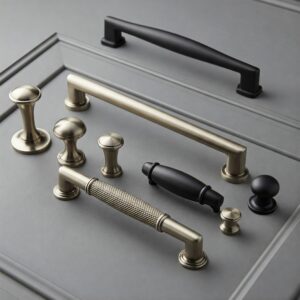
Value Considerations
When evaluating the cost of European kitchen cabinets, consider these value factors:
- Increased home resale value (typically 70-80% ROI)
- Extended lifespan compared to budget alternatives
- Reduced need for future renovations
- Improved functionality that enhances daily life
- Energy efficiency through integrated appliance designs
According to the National Association of Realtors, kitchen renovations consistently rank among the home improvements with the highest returns on investment, particularly when they incorporate quality cabinetry with broad appeal.
Ways to Optimize Budget
If you’re drawn to European kitchen cabinets but concerned about costs, consider these strategies:
✅ Mix high-end and budget components strategically
✅ Phase the renovation if possible
✅ Preserve existing layout to minimize reconfiguration costs
✅ Select standard sizes rather than custom dimensions
✅ Choose mid-tier rather than premium internal hardware
❌ Don’t compromise on drawer slide quality
❌ Avoid reducing cabinet box thickness
❌ Don’t select untested budget brands
Working with an experienced designer can help identify where investments will have the greatest impact and where savings can be found without compromising the overall quality and aesthetic.
Transform Your Kitchen With These Top European Cabinet Products
After extensive research and testing, I’ve identified several outstanding European kitchen cabinet products available on Amazon that can help you achieve the sophisticated look and functionality you desire:
For High-Gloss Enthusiasts
Liberty Hardware P01018-CHM-C Modern Cabinet Handle Pull offers the perfect finishing touch for European-style cabinets. These sleek, minimalist pulls are crafted from high-quality chrome that complements high-gloss cabinet fronts beautifully. The 128mm center-to-center measurement is the European standard, making these pulls ideal for updating existing cabinetry with a more continental aesthetic.
For Organizational Perfection
Rev-A-Shelf 448-BC-5C Base Cabinet Pullout Organizer brings European functionality to any cabinet. This chrome-plated steel organizer transforms standard cabinets into efficient storage systems with adjustable shelves and smooth ball-bearing slides—hallmarks of European design philosophy that maximize accessibility and organization.
For Handleless Design Lovers
Blum TIP-ON for AVENTOS HK-S 20K2C00.02 embodies the sophisticated push-to-open technology found in premium European kitchens. This system allows you to create the sleek, handleless look characteristic of modern European kitchen cabinets while maintaining perfect functionality for upper cabinets.
🌟Don’t Miss These Exclusive European Cabinet Upgrades!
➡ Take your kitchen to the next level with these carefully selected European cabinet components. Click on any highlighted item to check current pricing and availability. These products will help you create authentic European functionality and style that transforms your daily kitchen experience!
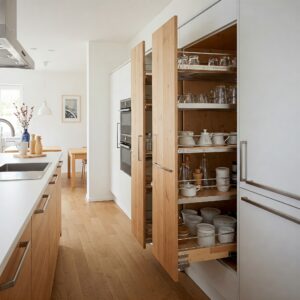
Maintenance Tips for European Kitchen Cabinets
Daily Care
To maintain the pristine appearance of European kitchen cabinets:
- Wipe surfaces with a soft microfiber cloth
- Clean spills immediately, especially on wood veneer surfaces
- Use gentle, non-abrasive cleaners appropriate for your specific finish
- Avoid excess moisture around cabinet seams and edges
- Periodically clean hardware and hinges according to manufacturer specifications
For high-gloss finishes, products specifically designed for acrylic surfaces will maintain the reflective quality without scratching.
Long-Term Preservation
To extend the lifespan of your European kitchen cabinets:
✅ Adjust hinges and drawer slides annually or as needed
✅ Check and tighten mounting hardware periodically
✅ Address any water leaks promptly to prevent damage
✅ Maintain consistent indoor humidity levels (40-60%)
✅ Keep cabinet interiors organized to prevent excess weight or stress
With proper care, high-quality European kitchen cabinets can maintain their functionality and appearance for 20-30 years or more.
Common Issues and Solutions
Be prepared to address these typical concerns:
| Issue | Prevention | Solution |
|---|---|---|
| Door misalignment | Regular adjustments | Use adjustment screws on hinges |
| Drawer slide sticking | Proper loading | Clean and lubricate mechanisms |
| Surface scratches | Protective practices | Touch-up kits from manufacturer |
| Hardware loosening | Periodic checking | Tighten or replace as needed |
| Moisture damage | Prompt attention to leaks | Contact professional for repairs |
Most European cabinet manufacturers provide detailed care instructions and can recommend appropriate products and techniques for their specific materials and finishes.
Customization Options for European Kitchen Cabinets
Color and Finish Possibilities
European kitchen cabinets offer extensive customization options:
- Solid colors from bright white to deep black and everything between
- Metallic finishes including aluminum, bronze, and brass tones
- Wood veneers in various species and grain patterns
- Textured surfaces that resist fingerprints and add tactile interest
- Mixed material combinations for unique design statements
Many manufacturers offer color-matching services to align cabinet finishes with specific paint colors or other elements in your home.
Special Function Additions
Beyond basic storage, European cabinets can incorporate specialized functions:
✅ Integrated appliance garages with lift or swing doors
✅ Charging stations for electronic devices
✅ Built-in recycling and waste management systems
✅ Custom inserts for specific cookware or serving pieces
✅ Illuminated interiors with motion sensors
These personalized features enhance the usability of your kitchen while maintaining the clean, integrated aesthetic that defines European design.
Dimensional Adaptations
Quality European cabinet manufacturers can accommodate unique spatial needs:
- Custom depths for specific applications
- Height variations to suit user ergonomics
- Special angle cuts for unusual room configurations
- Integrated solutions for architectural challenges
- Transitional elements to connect different cabinet zones
Working with a skilled designer can help identify customization opportunities that maximize your kitchen’s functionality while respecting the principles of European design.
How to Incorporate European Kitchen Cabinets in Different Home Styles
Modern and Contemporary Homes
European kitchen cabinets are a natural fit for modern architectural styles:
- Full integration with open concept living spaces
- Coordinated material palettes throughout the home
- Emphasis on horizontal lines and visual flow
- Minimalist hardware coordinated with door hardware throughout
- Strategic lighting that enhances cabinet finishes
In contemporary settings, European cabinets can serve as a central design element that sets the tone for the entire living space.
Transitional Adaptations
For homes that blend traditional and modern elements:
✅ Select European cabinets with subtle rather than stark finishes
✅ Consider wood veneers that add warmth and texture
✅ Incorporate some decorative hardware as a bridge element
✅ Mix cabinet styles strategically between perimeter and island
✅ Balance minimalist cabinets with more traditional countertops or backsplashes
This approach allows homeowners to enjoy the functionality of European design while maintaining connection to traditional architectural elements.
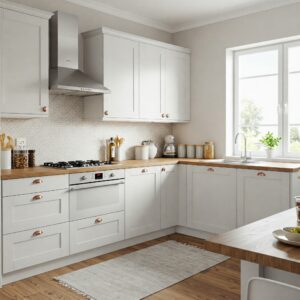
Small Space Solutions
European kitchen cabinets excel in compact environments:
- Vertical storage that maximizes ceiling height
- Integrated appliances that maintain visual continuity
- Reflective finishes that enhance perceived space
- Pull-out systems that provide function without visual bulk
- Consistent colors that create a sense of spaciousness
These strategies make European cabinet systems particularly valuable in urban condominiums, apartments, and smaller homes where space optimization is critical.
Sustainability Aspects of European Kitchen Cabinets
Environmental Standards
European manufacturers often adhere to stricter environmental standards than required in other markets:
- Compliance with European Union’s REACH regulations
- Adherence to E0 or E1 formaldehyde emission standards
- FSC or PEFC certification for wood components
- ISO 14001 environmental management systems
- Energy-efficient manufacturing processes
These standards reflect Europe’s long-standing commitment to environmental responsibility in manufacturing.
Lifecycle Considerations
The sustainability of European kitchen cabinets extends beyond materials to include:
✅ Durability that reduces replacement frequency
✅ Modular designs that allow partial rather than complete updates
✅ Recyclable components at end of life
✅ Energy efficiency through integrated appliance design
✅ Water conservation through specialized cabinet functions
According to the Environmental Protection Agency, products with longer lifespans generally have lower environmental impacts, making quality European cabinets a responsible choice despite sometimes higher initial resource inputs.
Certifications to Look For
When prioritizing sustainability, seek these credentials:
- FSC (Forest Stewardship Council) certification for wood components
- GREENGUARD or similar indoor air quality certifications
- EPD (Environmental Product Declaration) documentation
- CARB2 compliance for formaldehyde emissions
- Cradle to Cradle certification for circular economy design
These third-party verifications provide assurance that sustainability claims are substantiated and meaningful.
Future Trends in European Kitchen Cabinets
Technology Integration
The future of European kitchen cabinets is increasingly tech-focused:
- Smart cabinet systems with automated opening mechanisms
- Integration with home automation platforms
- Built-in induction charging surfaces
- Antimicrobial materials and self-cleaning surfaces
- Augmented reality interfaces for cabinet contents
These innovations build on the European tradition of forward-thinking functionality while maintaining clean, minimalist aesthetics.
Material Innovations
Emerging cabinet materials promise enhanced performance:
✅ Ultra-thin ceramic surfaces with exceptional durability
✅ Advanced composites with improved sustainability profiles
✅ Biotechnology-derived alternatives to traditional plastics
✅ Self-healing finishes that reduce maintenance
✅ Smart materials that respond to environmental conditions
Research and development in materials science continues to expand the possibilities for cabinet performance and sustainability.
Design Direction
Design trends in European kitchen cabinets suggest movement toward:
- Increased texture and tactile experiences
- Biophilic elements that connect to nature
- Customizable color systems for personalization
- Multi-functional components that adapt to changing needs
- Integration of traditional craftsmanship with modern technology
These evolving design directions maintain the core principles of European cabinetry while responding to contemporary lifestyle needs and preferences.
🏠Don’t Miss Your Chance to Transform Your Kitchen!
➡ Ready to elevate your kitchen with European-inspired elegance? Take the first step by exploring the premium cabinet options highlighted in this article. These carefully vetted products deliver the perfect balance of style, function, and value to bring your dream kitchen to life! Click any highlighted product to check current availability and pricing.
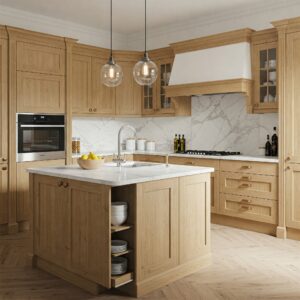
Conclusion
European kitchen cabinets represent more than just a design trend—they embody a philosophy that prioritizes function, efficiency, and clean aesthetics. From the precision engineering of German systems to the fashion-forward innovations of Italian designs, European cabinetry offers solutions that can transform any kitchen into a more organized, efficient, and visually appealing space.
While the investment may be higher than some alternatives, the longevity, functionality, and timeless appeal of quality European kitchen cabinets provide excellent long-term value for homeowners. Whether you’re renovating a compact urban apartment or designing a spacious suburban kitchen, the principles of European cabinet design can be adapted to meet your specific needs and preferences.
By understanding the distinctive characteristics, materials, and installation considerations outlined in this guide, you’ll be well-equipped to make informed decisions about incorporating European kitchen cabinets into your home. The result will be a kitchen that not only looks sophisticated but functions beautifully for years to come.
More FAQs
❓ How much more expensive are European kitchen cabinets compared to American styles?
✅ Typically 20-40% higher than equivalent quality American cabinets... This premium reflects advanced hardware, precision engineering, and superior materials. However, some budget-friendly European-style options are now available...
❓ What is the average lifespan of European kitchen cabinets?
✅ Quality European cabinets typically last 20-30 years with proper care... Premium German and Italian brands often exceed this timeframe, with some installations remaining functional for 30+ years when properly maintained...
❓ Can I retrofit European cabinet hardware to my existing cabinets?
✅ Yes, but with limitations... While European hinges and drawer slides can often be installed on existing cabinets, full functionality requires proper cabinet box construction. Retrofitting works best with solid-box construction cabinets...
❓ Are European kitchen cabinets difficult to repair if damaged?
✅ Most damage is repairable through component replacement... Unlike traditional cabinets requiring complete replacement, European systems allow for replacing individual doors, drawer fronts, or hardware components. Manufacturers typically stock replacement parts for 10+ years...
❓ What's the best countertop material to pair with European kitchen cabinets?
✅ Quartz, porcelain, and solid surface materials complement European cabinets best... These engineered materials offer clean lines, minimal seams, and contemporary finishes that harmonize with European cabinet aesthetics. Natural stones can work well with transitional European designs...
Recommended for You:
- 10 Stunning Frameless Kitchen Cabinets Ideas That Transform Your Space in 2025
- 10 Amazing Inset Kitchen Cabinets Ideas That Transform Your Home in 2025
- 10 Stunning Modern Gray Kitchen Cabinets That Transform Your Home in 2025
Disclaimer: This article contains affiliate links. If you purchase products through these links, we may earn a small commission at no additional cost to you.
✨ Found this helpful? Share it with your friends! 💬🤗
